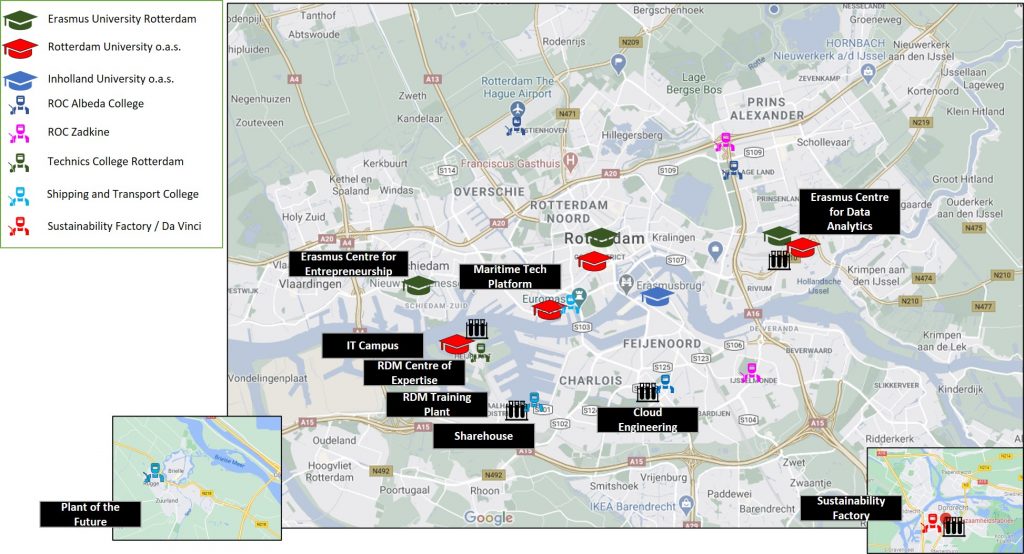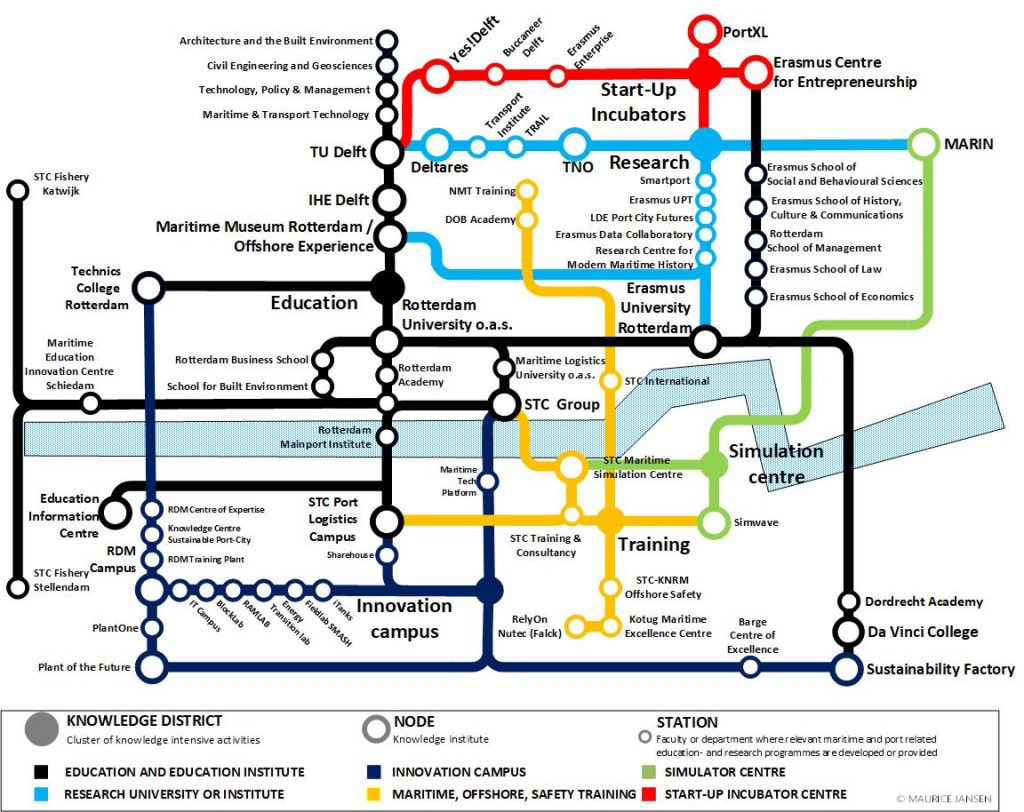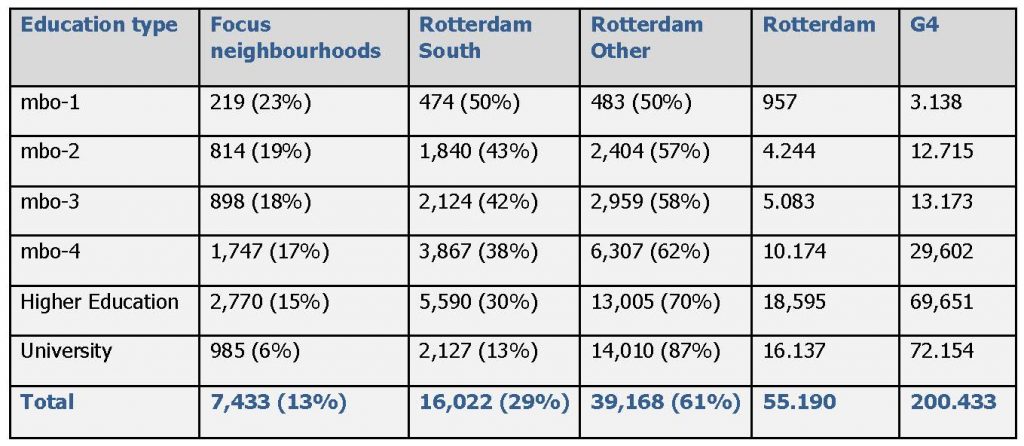Rotterdam’s education system has the wind in its sails, but at the same time it’s all hands on deck for Rotterdam. To remain a maritime capital and meet its ambition to become the world’s most sustainable port and an inclusive city, the port city is in need of human capital. As a port city that increasingly derives its competitive strength from smarter, cleaner and more efficient production and logistics, technology and talent development are of vital importance for innovation. Rotterdam is not unique in this ambition. Across the world, port cities are increasingly competing for the best talent. What can the port city of Rotterdam do to attract talent and realise its ambition to become a Maritime Capital while leaving no one behind?
The innovation ecosystem
To answer that question, we should look at what science has to say on how innovation ecosystems are emerging in cities. Explanations are found in various disciplines. Social geographers see the strength of a city in its agglomeration effects. Business scientists and economists see the densification of companies as behind cluster formation. Sociologists and cultural scientists talk about the presence or absence of social and cultural capital. Ecologists and biologists, meanwhile, talk about ecosystems: the circular principle and ‘nature’ and ‘nurture’.
We are increasingly seeing cities and companies adopting the principles of ecosystem formation. Often, they use the term in an abstract way, talking about an ecosystem of interrelated businesses, for instance. But in a port context, we see a tendency to also focus on the interplay between delta, society and economy. In times of climate change and pandemics, resilience is high on the agenda. Clusters of companies are more emphatically concerned about their environment, partly out of self-interest but also due to a need to join forces to tackle transition issues.
Businesses are making efforts to maintain and increase the livability of spaces, not only from a sustainability point of view, but also to be attractive as a location for talent. Other cities in the world express themselves as capitals of knowledge or talent, as shown by the Global City Talent Competitiveness Index. Rotterdam occupies a modest 28th place, well behind Amsterdam (21) and Copenhagen (1). How are these cities competing for talent? There is a strong relationship between regional income levels and the presence of technology, talent and tolerance (Florida 2003, Florida & Mellander 2020). A human capital perspective on the innovation ecosystem has also been applied to ‘smart cities’, ‘knowledge cities’ and ‘brainports’ in such areas. In port cities such as Rotterdam, this means a shift from trade networks to neural networks (Edvinsson, 2006): talent and technology will become increasingly important for the competitiveness of the port and industrial complex. But there is also a danger when investments in education and innovation campuses do not spread evenly across the city or region. Where investments are made in talent, the surrounding neighbourhoods flourish, but the gap with the neighbourhoods further away also increases (Florida & Mellander, 2020). This may be one of the reasons why Rotterdam South is progressing as a result of the long-term investments, but other parts of the city are further accelerating their economic development, perhaps because the talent there is working even harder on innovation.
Evolution of technical education in Rotterdam over the past thirty years
Rotterdam is a real student city, with almost 124,000 students, of which more than 50,000 are at vocational education level, 46,000 at higher education and 28,000 in scientific universities [1].
The city is known for its very extensive education and innovation ecosystem for the port and maritime sector with approximately 60 courses at all levels. This extensive range has been created over the years following various system changes in education. Technology education is also on a long road to recovery from decades of excessive concentration on larger education institutes where numbers became more important than people. In the Netherlands, the 1980s and 1990s were dominated by bankruptcies and the demise of renowned industrial companies. Shipbuilding was on the brink of extinction, while Dutch transport technology companies such as Fokker and DAF went bankrupt and had to restart with only intellectual property as their cores. Philips, with home base in Eindhoven, moved most of its factories to Eastern Europe and China. In contrast, business services and internet services were said to form the new pillars of the economy. It seemed the Dutch economy had said goodbye to the industrial era for good. This also influenced technical vocational education, as schools merged into large scale regional education centres with technical programmes receiving less and less students. It was only in the early 2000s that businesses realised that the number of technicians now lagged far behind their demand.

In Rotterdam, in-depth investments were made in various places in the city to strengthen the education and innovation ecosystem, both by area developers such as the Port of Rotterdam Authority and the Rotterdam Development Company. The redevelopment of the RDM Campus, Merwe-Vierhavens, Lloydkwartier and Waalhaven-Zuidzijde were part of the CityPorts (in Dutch: Stadshavens) program by the Municipality of Rotterdam and the Port Authority of Rotterdam, with the aim to revitalize these port areas. Most buildings and infrastructure of the quays had lost their functions and had to be refurbished.
Already since the 1990s, the Shipping and Transport College has been investing in technical education for the port, shipping and petrochemical industries in various locations on the north bank (Lloyd Quarter), south bank (Waalhaven harbour) and Brielle, a port town close to Europoort and Maasvlakte. These large-scale investments in technical vocational education infrastructure were made possible under the programmes ‘Knowledge Infrastructure Mainport Rotterdam’ and with European (EFRO) subsidies (Boivin et al. 2005, 2015). Meanwhile, the maritime manufacturing industry in the Netherlands had reinvented itself and required an increasingly larger number of graduates. The collaboration between Rotterdam University of Applied Sciences and the Shipping and Transport College in 2005 to revitalise Nautical Studies in Rotterdam was one of the first programmes in the Netherlands to restore the broken vertical connection between middle and higher technical vocational education that had arisen after the mergers of schools into the ROCs in the late 1990s. In 2011, this collaboration was further strengthened with the establishment of the Rotterdam Mainport Institute. Merging four port and maritime related higher education programmes under one roof gave a strong impulse to the learning communities at both Lloyd Quarter and the RDM Campus.
In the late 2000s, the technical vocational education system in the Netherlands got a new elan when the Stichting Platform Bètatechniek – a Foundation to promote education in technics and technology – was created by the Ministry of Economic Affairs, Ministry of Education, Culture and Science and Ministry of Social Affairs and Employment. The aim was to raise attention to technical education and ICT skills among school children. New forms of cooperation had to be created between educational institutions and the business community in order to solve the mismatch between skills needed and curricula at schools and universities of applied sciences. Investment funds were set up across the Netherlands for this. Top sector policy and centres of expertise were also created, 16 in total. In 2014, the Regional Investment Fund MBO was also introduced for secondary vocational education, which made the centres for innovative craftsmanship possible. 13 pilots took part in the first phase from 2014 to 2017, most of which participated in the second phase (2018-2022).

Examples of public-private partnerships here include the RDM Center of Expertise, which offers modern ‘context-rich’ learning environments. These are not only used for learning, but also for experimentations, testing and piloting, always set up as joint projects between education, research and business. Shipping and Transport College continued to build its port logistics campus in two phases at the Waalhaven South Side. The Technology College Rotterdam was also created after a mandatory merger of the technology courses between the ROCs Zadkine and Albeda College forming the RDM Campus. On the north bank, Erasmus Center of Entrepreneurship moved into the Science Tower in 2015, with a view over the M4H Makers District, to stimulate education and research in the area.
These new partnerships between educational institutions are not only intended to adapt education to this age of rapidly advancing technology, but also to re-connect education and business and recreate continuous learning paths. This trend has been going on for several years in vocational education. Scientific education is also looking for new connections with the city from the point of view of ‘societal impact’. One of the partnerships is Sharehouse, a unique learning environment where Erasmus University researchers test the collaboration between humans and robots in a warehouse environment. The IT Campus is also actively looking for these vertical connections aiming to raise the level of digital skills across all levels of education.
What’s happening on the South Bank?
Approximately 205,000 people live in Rotterdam South, almost a third of the population of the city, with 70,000 under the age of 27 years. The population in South Rotterdam is growing, and so is the age group up to 27 years. In 2019, however, Rotterdam South was still lagging in education, on the labour market and on the housing market (RISBO/OBI, 2020). The educational level of parents is lower, the school recommendation in group 8 is lower compared to other neighbourhoods in Rotterdam and the G4 – the four largest cities in Netherlands – school absenteeism is highest. In so-called ‘focus neighbourhoods,’ the socio-economic position of children is even lower than the average in South Rotterdam. Relatively speaking, more mid-vocational students live in Rotterdam-South, while the number of university students living in the South is lagging far behind.

Talent is especially needed in IT and data sciences
Rotterdam can position itself more powerfully as a talent city. Recent research by Erasmus UPT shows that companies closely monitor technological developments: big data analytics, artificial intelligence, internet of things. Where technology and talent have to come together, the question arises whether a mismatch will arise between what the business community demands and what education can deliver, both qualitatively and quantitatively. The learning communities that have emerged since 2010 show a new form of learning that fits the 21th century. Learning takes place in a network and (personal) knowledge is related to the network of people, organizations and institutions in which the knowledge worker works and lives. This connectivist view of education is illustrated by the ‘metro map’ of Rotterdam maritime education, but it also applies to other sectors. Companies are still looking for craftsmanship, but digital and social skills are transversal, according to the talent survey. This research also shows that companies find it difficult to find IT professionals: data specialists such as data engineers, data analysts, data scientists, developers, and also talent with a business informatics education. In addition, technical vocational skills – such as seamanship, shipbuilding or maintenance technology – can provide a strong basis for developing talent. Learning professional communities and innovative learning environments offer opportunities to make crossovers between craftsmanship and data sciences. A target group-oriented approach to bind IT professionals more inclusively to the city will benefit the innovation processes in the present business community along this line.
Coming to conclusions
Attracting, retaining and growing talent is increasingly becoming a competitive factor for both companies and cities. Rotterdam can position itself even more strongly as a talent city and make use of its rich education and innovation ecosystem, but will have to make careful and balanced future investments in area development. On the South side of Rotterdam in particular, considerable efforts have been made for years to make the neighbourhoods more livable and attractive, but for young people on this side of the river, catching up is not easy. The question is whether Rotterdam South can ever measure up to ‘north’. The river is not just a physical barrier. Several barriers create a gap between north and south for young people: primary school test scores, education level, dropouts, youth unemployment, disposable income. Across the board, these Rotterdammers are already falling behind early in their lives. For an integrated plan to succeed, perspectives from urban planning (architecture and the built environment), new business development, sociology and the maritime culture and identity converge. In this holistic perspective it is about reducing distance for young people, in physical proximity and in travel time, but also institutionally. There is enormous potential in the residents of Rotterdam South. In these neighbourhoods, young people look for inspiration, for a stepping stone. A hybrid learning community – perhaps a university for IT and Data Sciences talent – can provide horizontal connections between training programs as well as vertical connections that form learning pathways for the underprivileged. Rotterdam is up for the challenge and can make it happen in the spirit of the port city: stronger through stride.
Head Image | Shipping and Transport College at Lloyd Quarter. (© Maurice Jansen, 2017).
Note
[1] DUO Database, participants and registered participants, reference date 1/10/2019.
References
Boivin B., Hietbrink E., Rosenberg, J.P. (2005) ‘Baken aan de Maas’, Scheepvaart en Transport College.
Boivin, B., Hietbrink E., Bosker, A. (2015) ’STC-Group 25 jaar op Koers’, Scheepvaart en Transport College.
Edvinsson L. (2006) ‘Aspects on the city as a knowledge tool’ in Journal of Knowledge Management.
Florida R. (2003), Cities and the Creative Class. City & Community.
Florida R., & Mellander, C. (2020). Technology, talent and economic segregation in cities. Applied Geography, 116.
Hooft Van Huijsduijnen, L., Van Hulle, R., Marchal, B., Van der Lelij, M., Zwanenveld, J. (2019) ‘Landelijke Monitor Studentenhuisvesting 2019, Delft.
Jansen J., S.Y.Tjong Tjin Tai, J. van den Broek & J. Deuten (2020) ‘Stad zoekt toga; universiteiten en hogescholen als structurele kennispartner voor gemeenten’, (2020), Rathenau Instituut, Den Haag.
Jansen M. (2020) Port innovation ecosystem, a symbiosis of capital: a case study of Rotterdam, IAME2020 Sustainable Development of Shipping and Trade 10-13 June 2020, Hong Kong (online).
Jansen M., Vermeulen S., Van Haaren J. (2020) ‘Rotterdam, thuishaven voor talent; onderzoek naar talent- en talentinitiatieven in Rotterdam maritieme hoofdstad van Europa’, in opdracht van Gemeente Rotterdam.
Risbo (2020), ‘Basismonitor Onderwijs Nationaal Programma Rotterdam Zuid 2019’, Erasmus Universiteit ism Gemeente Rotterdam.